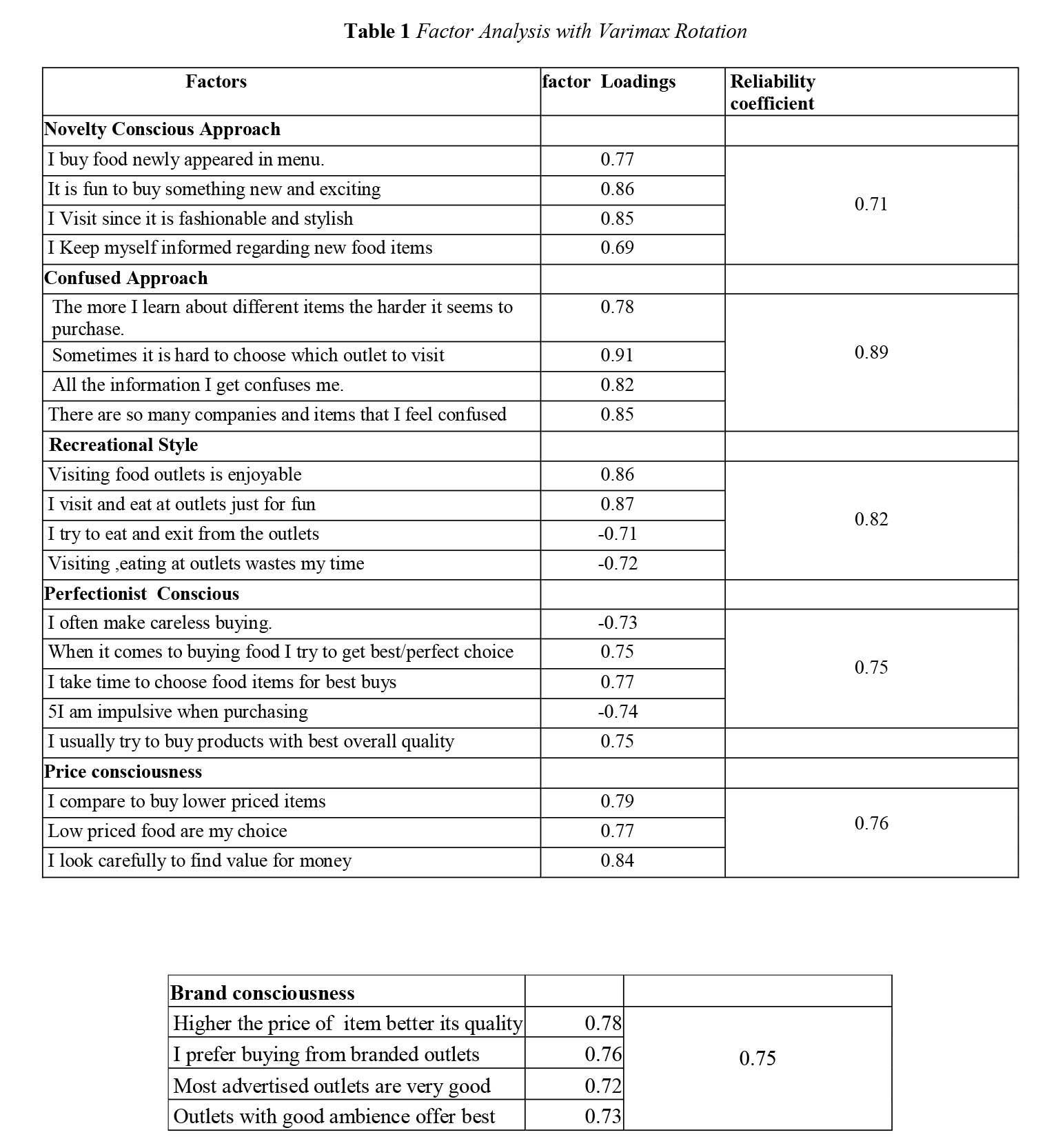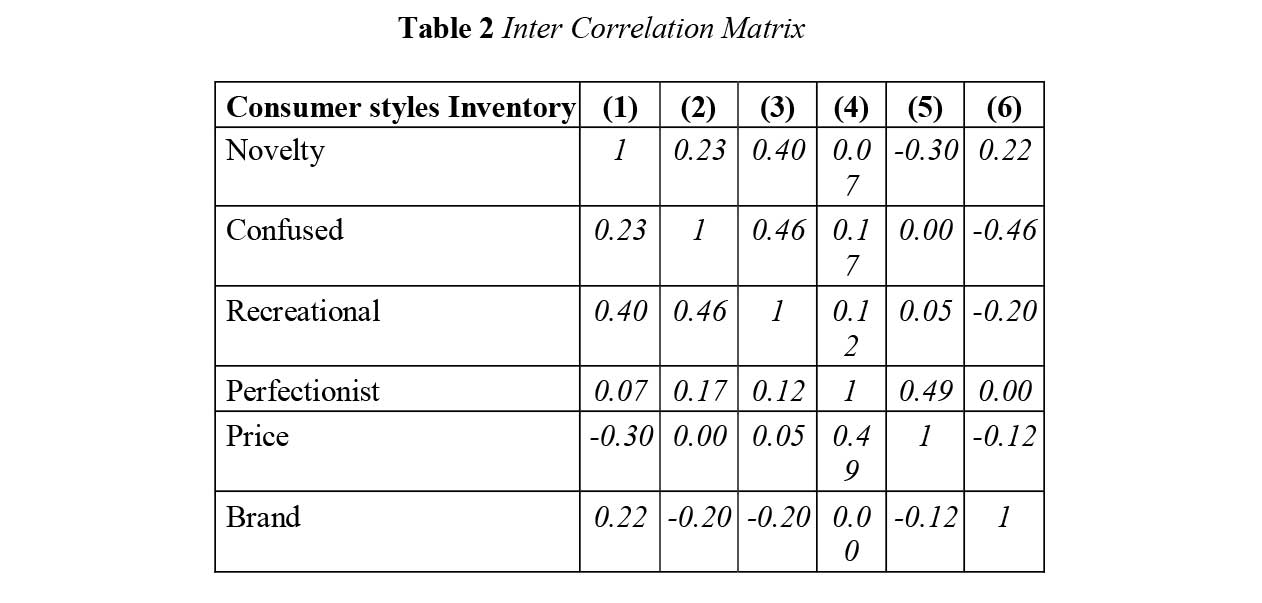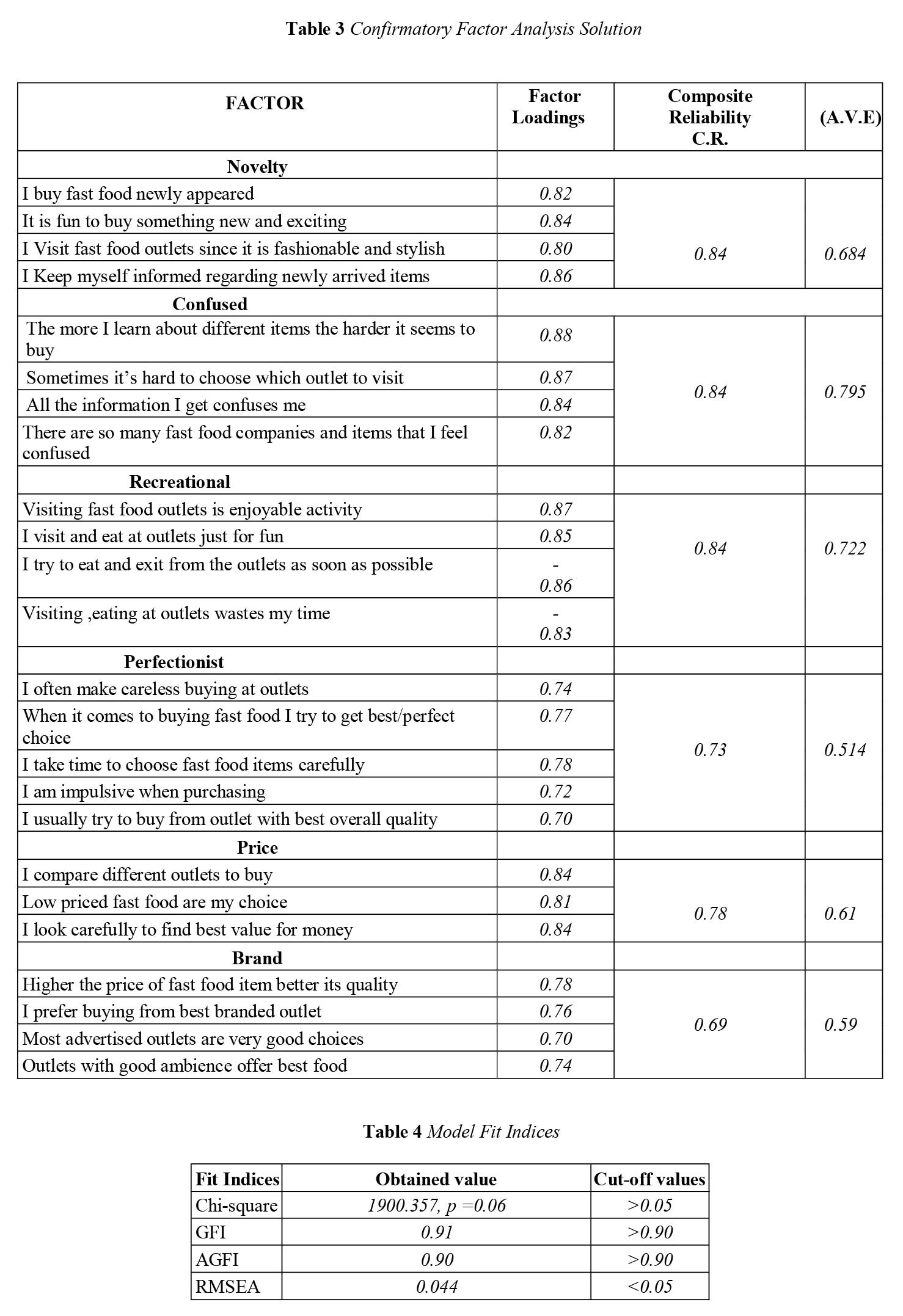Subscribe now to get notified about IU Jharkhand journal updates!
Consumer Styles Inventory of Indian Youth towards Fast Food Outlets
Abstract :
The present study attempts to investigate the Consumer Styles Inventory of Indian youth with reference to fast food outlets. The study was conducted among a sample of respondents in Kerala.. Factor analysis was used to measure the consumer styles Inventory. The study revealed the confirmation of six factors. Further, the young consumers were profiled using cluster analysis technique
Keywords :
Consumer Styles Inventory, Young Consumers1. Introduction
The young age can be considered as the crucial time phase of any individual's life. During this phase, youth undergo major transformations which further influence their life stages. An individual's consumption of various products begin to take shape during this age. The United States General Assembly defines 'youth' as those individuals belonging to the age group of 15-24 years. The present youngsters of India stand apart in terms of their massive size, consumption of products/services and intellectual ability. India is the youngest country in this world (Narang, 2010).
For the present day young Indians, shopping is more of an experience. The young consumers possess lesser commitments. Their immense love for shopping and spending power trigger them to go in for the purchase and consumption of a wide variety of products existing in the market. The youngsters tend to show attachment towards materialistic values and possession. They try to purchase those products and brands that ensure them acceptance among their friends and peers. The preferences of young consumers change in such a dynamic manner that it makes it even more difficult to identify their needs. This consumer segment has immense impact on marketers and retailers. Hence, there is a need for pursuing continuous research works focused upon the youth to offer guidelines to marketers and retailers in effectively targeting this consumer segment.
Consumer Styles Inventory
Consumer decision making style refers to a mental orientation characterizing a consumer's approach to making choices. It is a consumer personality similar to the concept of personality in Psychology (Sproles and Kendall, 1986). In order to establish the decision making styles, a model known as 'Consumer Styles Inventory' was framed. This is the most tested instrument available to assist marketers in examining consumer decision making styles.
In order to measure decision making styles, Sproles and Kendall (1986) listed down the major characteristics of consumer decision making. The following eight dimensions of decision making were identified as follows – 'High quality consciousness', 'Brand conscious approach', 'Novelty conscious', 'Recreational consciousness', Price conscious , Impulsiveness, Confusion and 'Habitual brand-loyalty'. This measurement scale enables the testing of consumer decision making styles. The scale is a useful technique to analyse consumers regarding their orientation towards shopping. Moreover, the consumer styles inventory can be used for profiling a consumer's style, in educating and in counseling.
The study attempts to investigate the decision making styles of youth with reference to fast food outlets. The researcher has chosen the state of Kerala in India as the study area. The fast food brands considered for the study are – Mc Donald's, Kentucky Fried Chicken, Subway, Domino's, Pizza- hut and Cafe Coffee Day.
Literature Review
The current percentage of youth in India is 50% as per Government of India's Department of Youth Affairs portal. The spending power of youth is estimated to be in billions of US dollars. Fast food is gaining increasing popularity from Indian youth. Decision making has attained a more complex framework in today's scenario. Researchers are interested in identifying the decision making styles of consumers. Researchers have cited the need for future research works on 'consumer styles Inventry'.Based upon research gaps, the researcher attempts to study the styles of youth towards fast food outlets.
Research Methodology
A structured questionnaire comprising of 36 items was used. The scale was adopted from Sproles and Kendall's (1986) Consumer Style Inventory to measure consumer decision making styles. Likert scale was used with scores ranging from 1 (strongly disagree) to 5 (strongly agree).The population for the study comprised of all the young consumers in the age group of 15- 24 years. The sampling frame comprised of young consumers visiting the organized fast food outlets. The Krejcie and Morgan's (1970) model was used for calculating the sample size required for the study. A sample size of 678 was derived for the study population. Mall intercept technique was used for data collection.
Results and Discussions
Factor analysis with Varimax rotation (Exploratory factor analysis) was performed to identify the dimensions underlying consumer styles inventory. The exploratory factor analysis was followed by confirmatory factor analysis to test the validity of the factors underlying consumer styles inventory.
Table 1 highlights the Varimax component matrix and reliability coefficients of six factor decision making style model. The Cronbach's alpha coefficients are found to be satisfactory. The six resultant decision making styles are described below:
- Novelty conscious– Respondents with high scores on this particular characteristic gain immense excitement and pleasure from seeking out novel things. They are updated about the latest trends. Novelty conscious consumers always seek for variety products/services.
- Confused Style - It is to be inferred that the respondents of the current study experience some sort of confusion while selecting their preferred fast food brands and items. The consumer perceives each and every brand as equally good thereby resulting in confusion while selecting the right one.
- Recreational consciousness- The confirmation of this factor indicates that the respondents visit fast food outlets with a recreational mind set seeking for fun and enjoyment during these visits. As far as the recreational or hedonistic consumers are concerned, shopping is never a waste of time for them.
- Perfectionist consciousness- Respondents coming under this category are very systematic and careful in their shopping endeavors. They plan intensively before their shopping visits.
- Price consciousness – Respondents scoring high on this particular factor are very conscious regarding the money spent by them on products or services. They are very cautious in getting the best value for money in whatever they purchase
- Brand consciousness – The confirmation of this particular factor implies that the respondents of the present study visit organised fast food outlets owing to their high brand consciousness. The respondents prefer to buy fast food from branded fast food outlets.

Test of Validity
Confirmatory factor analysis (CFA) was performed to test the validity of factor solution underlying consumer decision making styles resulted from exploratory factor analysis. Table 2 highlights the inter correlation matrix of consumer decision making styles which indicates absence of multi- collinearity. The factor solution was examined for its convergent validity and discriminant validity.

Table 3 highlights the confirmatory factor analysis solution along with values for composite reliability and AVE . Table 4 indicated the Goodness of Fit for the Confirmatory factor analysis solution. The various fit indices namely Chi-square (p =0.07), Goodness of fit index (GFI) (0.925), Adjusted Goodness of fit index (AGFI) (0.902) and Root Mean Square Error of Approximation (RMSEA)(0.047) satisfied the required criteria for Goodness of Fit.

Profiling of Respondents
The solution was subjected to hierarchical cluster analysis using Ward's method. The agglomeration schedule and Dendogram indicated the acceptance of two clusters. Following the hierarchical cluster analysis, K-Means mode of non-hierarchical clustering was examined for a 2 cluster solution.
The study reveals the following two clusters :
Cluster 1: 'Recreational and Price conscious' – 54.9% of respondents belonged to this cluster. Respondents belonging to this cluster possess recreational and hedonistic consciousness towards visiting organised fast food outlets and consumption of fast food. They are also found to be price conscious during their transactions and are very particular in purchasing and consuming high quality fast food dishes.
Cluster 2: 'Novelty and Brand conscious youth'– This segment constitutes 45.1% of the total respondents considered for the study. These set of respondents found pleasure in seeking out for newly arrived fast food items in the menu. They are not hesitant in trying out new and novel fast food dishes. These respondents are also found to be brand conscious
Discussion
The fast food companies may take important implications from the findings of the study relevant to consumer styles inventory of respondents. The management may also take note of the decision making styles which emerged in this study. The managers may take efforts to frame appropriate and unique strategies for consumers possessing different decision making styles. Future studies may be conducted to investigate the decision making styles of youth with respect to other products and services. There is scope for analysing the influence of culture on decision making styles of youth since India is a country with vast cultural and geographical diversity.
Conclusion
The youth offers tremendous opportunities to the marketers. The companies targeting young consumers can benefit if they manage to understand the psychological orientations of this segment. The present study is an earnest attempt to understand the consumption behaviour of youth with respect to their 'consumer styles inventory' towards organised fast food service. The study confirmed the presence of both desirable (e.g. perfectionist-high quality consciousness and price consciousness) and undesirable (e.g. confused by over choice) consumer styles inventory among the young consumers.
Hence, the current study has attempted to make a valuable contribution to the existing literature relevant to consumption behavior and relevant psychological dimensions of young consumers.
References
- Anic, I.D., Suleska, A.C., and Rajh, E., (2010), Decision making styles of young adult consumers in the Republic of Macedonia, Ekonomska Istrazivanja, 23 (4) :102-113
- Bakewell, C., and Mitchell, V.W., (2003), GenerationY female consumer decision making styles, International Journal of Retail and Distribution Management, 31 (2): 95-106.
- Ernst and Young (2007-08), Retail: Market and opportunities, http://ibef.org/download/Retail_220708.pdf (accessed October 20, 2011)
- Goyal. A. and Singh N.P. (2007), Consumer perception about fast food in India: an Exploratory study, British Food Journal, 109 (2):182-195.
- Krejcie, R.V. and Morgan, D.W. (1970), Determining sample size for research activities, Educational and Psychological Measurement, 30: 607-10
- Lysonski S., Durvasula S. and Zotos Y., (1996), Consumer decision-making styles: a multi-country investigation, European Journal of Marketing, 30(12): 10-21
- Narang, R. (2010), Psychographic segmentation of youth in the evolving Indian retail market, The International Review of retail, distribution and consumer research, 20(5): 535-557
- Ramaswamy V.S., and Namakumari S. (2009), Marketing Management in Indian Environment, Macmillan
- Sproles G.B. and Kendall E.L. (1986), A methodology for profiling consumers' decision-making styles, The Journal of Consumer Affairs, 20 (2): 267-279
- The Marketing Whitebook (2012-13), The food and grocery market, Businessworld, New Delhi, pp 200-201
